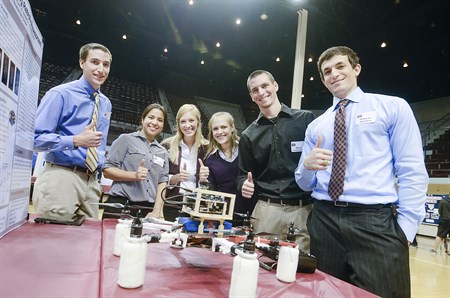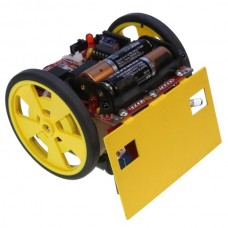Schedule
Program
Competitions
Rules for all competitions will be posted by January 22nd.
Paper Competition
The IEEE Student Paper Contest gives undergraduate IEEE Student member the opportunity to exercise and improve both written and verbal communication skills. Throughout an engineer's career, he/she will be constantly called upon to communicate ideas to others.
Researching,writing, and presenting a paper provides a student with invaluable early experience in expressing ideas related to engineering. Since the paper contest's primary function is to improve the engineering student's communicative skills, no student should be discouraged from entering the contest due to a false requirement of technical sophistication. Click Here for the Rules to the Paper Competition
To submit a paper please email it here with the names of the author and the title of the paper in the subject bar and the paper attached in PDF format.
T-Shirt Design Competition
Students will compete against each other to create a T-Shirt design that best represents the 2018 Pitt IEEE Region 2 Student Activities Conference (SAC). The winning design will be displayed on the official IEEE T-Shirts worn at SAC.
This competition is meant to promote student creativity through the use of graphic design and students' imagination. The hopes are that an aesthetically pleasing design will attract the attention of on-looking passersby and encourage them to inquire about IEEE.
Click Here for the Rules of the T-shirt Competition

Project Showcase
The Project Showcase allows undergraduate students, as individuals or teams, to
demonstrate what they have learned or worked on throughout their undergraduate career.
Projects/designs (other than competing robots) can be related to school, work, or
extracurricular activities that pertain to electrical and/or computer engineering.
Click Here for Rules of the Project Showcase
Brown Bag Circuit Competition
In the Brown Bag Circuit competition each team consisting of 1-4 members will be given a bag
of various components and then will be required to complete a challenge with some or all
of the components. Each team will use only the components and documentation provided
to complete the challenge. They may not use additional notes, references or aids, but
must rely on their knowledge and ingenuity.
Click Here for rules for the Brown Bag Competition

Sumo Kit
Two teams place an autonomous Pololu Zumo robot in a circular ring called a Dohyo, and much like the traditional Japanese martial art of Sumo wrestling, each robot attempts to push the opposing robot out of the ring. Once one of the robots has been pushed out of the ring, the round is over, and the one who remains in the Dohyo is considered the winner. Whichever team's robot successfully wins two rounds is permitted to proceed to the next tier of the competition. In the kit competition, all teams will have the exact same robot; it is up to the team to write the best and most strategic code in order to win.
Click Here for rules to the Sumo Kit Competition
Sumo Scratch
Two teams place an autonomous robot in a circular ring called a Dohyo, and much like the traditional Japanese martial art of Sumo wrestling, each robot attempts to push the opposing robot out of the ring. Once one of the robots has been pushed out of the ring, the round is over, and the one who remains in the Dohyo is considered the winner. Whichever team's robot successfully wins two rounds is permitted to proceed to the next tier of the competition. In the sumo competition, teams are free to design and build their own robot; it is up to the team to combine excellent design and code in order to win.
Click Here for rules to the Sumo Scratch Competition
Micromouse
Roughly 40 years ago, Donald Christiansen challenged the readers of IEEE Spectrum to design miniature maze solving micromice for a contest. Only two of the mice got through the maze. 10 years after that first contest, there had been competitions in Japan, France, and Britain, and the competition had advanced to the point where it was no longer a question as to whether the maze would be completed, but rather how fast it would be completed. And now, in our own little corner of a long standing tradition, the University of Pittsburgh welcomes you to the 2018 IEEE SAC Micromouse competition.
Click Here for rules to the Mircromouse Competition
Ethics
The SAC Ethics competition deals with an aspect of engineering that is often forgotten. Does my work infringe on the rights or safety of others? Are there conflicts involving intellectual property? A case study which deals with these issues will be presented to participants the day of the competition. They will have a period of time to prepare a presentation with a response in accordance to the IEEE code of ethics, which will be presented to a panel of judges. The presentation will be followed by a brief Q and A session. This competition is an opportunity to explore a prospect of engineering work that is not particularly glamorous but is extremely important.
Click Here for rules to the Ethics Competition
Physics Competition
This competition will consist of a design challenge and a conceptual portion. This competition will require a basic understanding of mechanics and experimental design. All materials will be provided and participants will not be allowed to use any supplies not provided. A detailed rule sheet will become available the day of the competition.
Click Here for rules to the Physics Competition

Women in Engineering (WIE) Outreach: IEEE Design Lab
Similar to the physics competition, the event will be centered around a design challenge. IEEE participants will be matched with middle school girls to mentor them through the challenge and inspire the next generation of female engineers, particularly in the fields with the largest gender gaps, such as electrical engineerinng or computer science. All materials will be provided and participants will not be allowed to use any supplies not provided. A detailed rule sheet will become available the day of the competition.
Click here for the WIE Outreach Rules